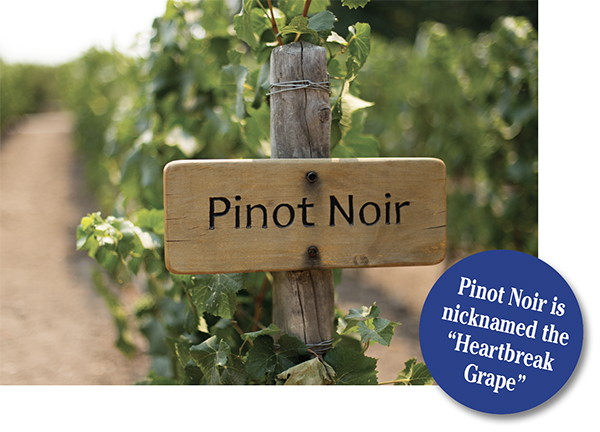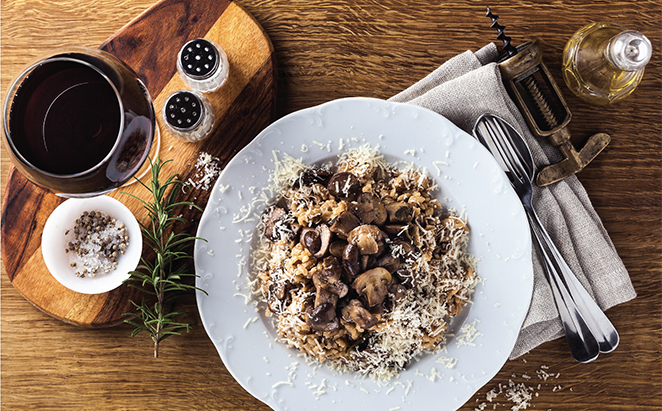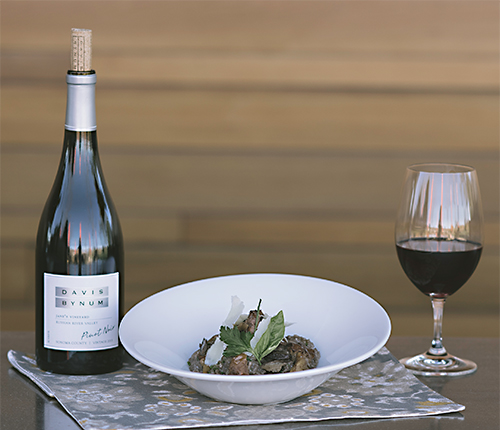Getting to Know Pinot Noir
National Pinot Noir Day
Some of the most beautiful wines made from this variety embody a nuance that intrigues wine lovers and winemakers in a pursuit of the perfect Pinot. It’s character is often challenging to describe as it shifts and morphs with clonal varieties, winemaking temperaments, growing region and age. In cooler-climate regions where the grape thrives, a youthful quality offers flavors ranging from cherries to red ripe raspberries. As a Pinot Noir matures, the wine deepens and develops dimensions of moss, forest floor, mushroom and soft violets. Whether the wine is youthful or aged, it’s signature attribute is a sublime symphony of silk and structure offering balanced fruit, alcohol, body, acidity and tannin.
The word etymology of Pinot Noir is derived from the two French words for pine and black. Pine refers to the variety having tightly clustered, pine cone-shaped bunches of fruit. In Germany, the vine is called Spatburgunder and in Italy you will find it called Pinot Nero. It is regarded as one of the world’s noblest of wine varieties.
Ancient Romans referred to Pinot Noir as Helvenacia Minor and made wine of this grape as early as the first century AD. In Italy it is the grape that is used to make Franciacorta. It is also the grape varietal, along with Chardonnay and Pinot Meunier, that is used in the sparkling production in Champagne and other wine regions.
It’s reputation as a world-renowned table wine, however, and where the grape is mainly associated, is owed to what some call it’s birthplace of Burgundy, France. Today, Pinot Noir grapes are grown around the world, mostly in cooler climates and it’s reputation of making equally paralleled wines in style and desire can be found in the regions of Willamette Valley of Oregon, the Carneros, Anderson Valley, Central Coast and Russian River AVAs of California, as well as areas in South Africa, Australia and New Zealand. California Pinot Noir producers, in particular, have made their way to the top of the list of beloved wines.

GET THE DIRT
Understanding terroir and its influences
Pinot Noir has many clone options available to produce wines of different profiles. This is due to the highly susceptible genetic variation of the grape. The commonality of this varietal, however, is that it is rather finicky about its growing conditions. It typically produces its best fruit in areas where the conditions are cool and often foggy.
The tightly packed clusters of this grape make it susceptible to many growing and viticultural hazards including rot which require diligent vineyard management. In addition, this thin-skinned grape with low levels of phenolic compounds lends the wine to be very light in color and low in tannin which can sometimes affect the aging process of the wine. Phenolic compounds are the natural chemical compounds found in grape skins that can affect the taste, color and feel of the wine. Pinot Noir is also sensitive to wind and frost. To produce the best quality wine, crop control and proper pruning techniques are necessary. Low yielding vines and high concentration fruit profiles will give way for the best quality Pinot Noir. In essence, Pinot Noir is highly reflective of its soil types, vineyard management style and weather.
SWIRL, SNIFF, SIP, SAVOR
How to identify wine in the glass
The general profile of a Pinot Noir wine include a light to medium bodied wine with mostly red fruit profiles, as well as other small berried currants. It is a low tannin wine with a higher acidity with spicy notes of vanilla, baking spice and caramel typically from the French Oak barrels used for aging. Other earth elements the nose include wet leaves and soft tobacco.
Pinot Noir tends to show a soft garnet color in the glass with gently puckering acidity and a graceful tea-like tannin that feels velvety in the mouth. On the nose, the wine can show notes of black cherry, raspberry, black tea, forest floor moss and cloves.
The wine creates an impression on the palate and in the memory with its complexity and nuance. Sometimes the wine will offer mushroom or barnyard components which many tasters find quite appealing indicating moments of time and place.

HOW TO PAIR LIKE A PRO
Pinot Noir is a very food-friendly wine that can give a lot of options for a host of palates and dishes. It is a lovely harmonizer that pairs well with a wide variety of foods. That being said, Pinot Noir, like all varietals, seems to go particularly well with some classic dishes that best show the texture and delicacy of the grape.
Pinot Noir is light enough for salmon and swordfish and complex enough to bump up against duck breast, lean pork roast, Boeuf Bourginon and Coq au Vin or chicken in red wine. Any dish with mushrooms as the main flavor component is dreamy with a Pinot Noir. Other main dishes that match well with this grape include roasted and braised cooking preparations of pheasant and lamb. Some of the best pairings are food that is simple and saucy with little to no spice. Herbaceous notes of rosemary and sage compliment this wine nicely, but go easy on other spices that may be too hot and drown out the soft petals of the wine.
For the vegetarians in the group, Pinot Noir is absolutely delicious with root vegetables, jackfruit, mushrooms, grilled vegetables and rich rice dishes such as risotto or polenta. This wine also pairs beautifully with figs, cherries and cheeses including goat cheese, brie and gruyere.
Since Pinot Noir has many different styles and profiles depending on region, age and clone, there are some general guidelines to consider when choosing a wine. For example, lighter, fresher more budget-friendly Pinot Noirs can often pair well with charcuterie, ham, patés and rustic French dishes such as rabbit or kidneys with a mustard sauce. Sweeter, more New World style juicy Pinot Noir with bright berry fruit can offer a nice palate shift for even a lightly spicy barbecue or any dish with cherries or figs.

Wild Mushroom Risotto
(Serves 4)
ingredients
1 cup Arborio Rice
2 shallots, finely chopped
2 garlic cloves
2 cups wild mushrooms
4 cups mushroom stock
½ cup Pinot Noir
1 tbsp. chopped parsley
directions
1. Heat olive oil in a saucepan, gently sauté the shallots and garlic for 2 or 3 minutes, until softened but no browned
2. Add mushrooms and cook until soft, add the rice, cook for 2 minutes, continue stirring, add wine cook until dry.
3. Add a ladle full of stock stir until the liquid in been absorbed, continue add liquid until the rice is creamy and cooked.
4. Stir parmesan, parsley and adjust seasoning.
Suggested wine: Pinot Noir Davis Bynum
Courtesy of Rodney Strong Vineyards
Stephanie Culen is a Certified Sommelier, Wine Scout and Personal Wine Consultant and currently works at Passalacqua Winery in Healdsburg, California. She is a contributing writer for Wine Country This Week, as well as www.whichwinery.com, an online resource for wines and wineries around the world.